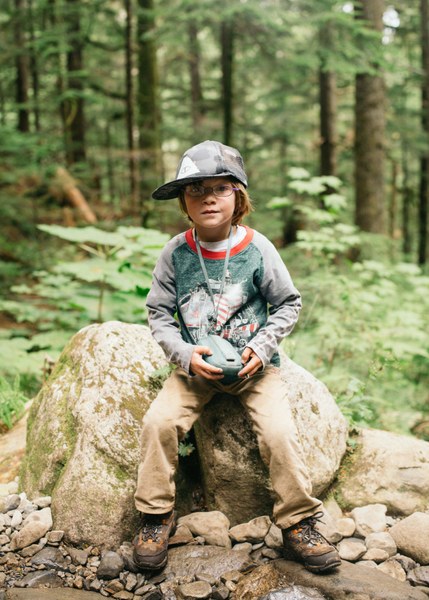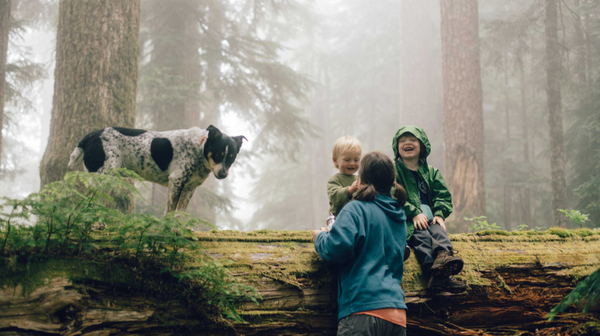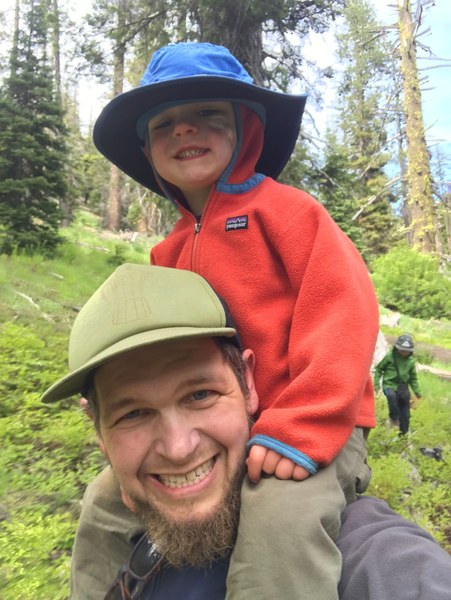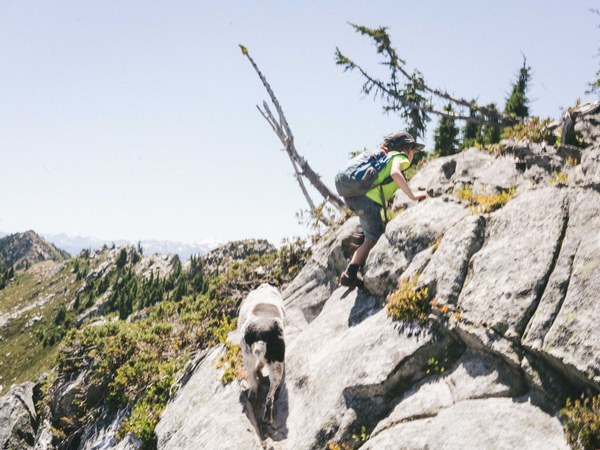
The fourth time my 6-year-old fell down on the muddy trail and screamed like there was no tomorrow, I thought, “hmmm… maybe we should turn back.” Then I figured he’ll be fine - it’s all part of getting outside. To be fair, he kept falling because he was wearing his mom’s (giant for him) rain boots, because he’d forgotten his own boots. He also forgot his shoes, and we didn’t drive an hour to not go for a hike because our kid forgot his boots when we had a perfectly good pair of rain boots in the car. Lesson learned: double-check footwear for all family members. See also: socks, pants, gloves, hats… you get the idea.
These things happen. When you have kids they happen a lot. The no boots, not enough trail mix, tired legs moments. The falling in cold mud, falling on dry dusty rocks, falling in the lake moments. The “Dad, I’ve gotta poop,” “Dad, I just peed on myself,” and, “Dad! I tried to poop but got it all over myself” moments. But for each one of those moments you get so many “This is awesome,” “Dad, look at this mushroom,” and “check out that bird” moments. The “can we go for a longer hike tomorrow” moments, the 5-year-old bombing down the ski hill with the 9-year-old skiing switch right behind him moments, the mouthful of huckleberries moments. Nothing beats a muddy kid with a giant smile on their proud face.
Because people seem to like lists as much as my kids like berries, here is a list of 10 things we learned over the past decade of getting outside with kiddos.
Pre-list disclaimer: this is my experience with my kids. All kids are different and all parenting styles are different. Generally, I dislike parental advice and thus this is not intended to be advice. This is intended as an insight into what our family has done to integrate outdoor adventure into our lives after having kids. As a parent, I firmly believe that none of us have any idea what we are doing. On that note, on with the list:
Start early
In our experience, we decided to get the kids out before they could object. We started hiking with each kid at birth and were camping by 3 months, skiing by 3 years, and so on. This, of course, came with challenges. You bring a lot of stuff to accommodate a newborn. They’re not moving much, so keeping them warm is important. They also have an appetite like a hummingbird so meal stops are frequent. You must be prepared for the occasional diaper blowout (aka when poop escapes the diaper and gets everywhere) and have plastic bags to pack out dirty diapers. On the upside, babies are lightweight and immobile, and on a busy trail you get nice smiles from strangers. Plus, babies get acclimated to being outside and they easily accept the outdoors as a regular part of their lives.
 Giles looking out on Heather Lake at age 5.
Giles looking out on Heather Lake at age 5.
Be as prepared as possible
As a Mountaineers member, you know the importance of proper preparation. For a typical hike with walking-age kiddos, you will need: the 10 Essentials, snacks, extra clothes, extra socks and underwear, extra gloves, patience, wag bag/blue bag/some kind of bag to pick up kid poop, toilet paper (pack it out), snacks, lunch, snacks, many layers, boots, kid carrier (if the kiddo is small enough), snacks, a lot of water, water filter (not totally necessary but not bad to have along - plus it’s fun for kids to pump), swim clothes, field guild, maps, GPS app, plus a backpack to fit all of that stuff with plenty of room for the sticks and rocks your kids decide they want to bring home. For the car: books, toys, and snacks. I have a bin system to make packing easy. I have bins for different activities and seasons, that way it is harder to forget things. In case you didn’t notice, snacks are super important: kids burn a lot of energy and need a near-constant stream of food. Nuts and fruit are our favorites.
Get out with other parents
Other people have kids too. Some of those people are also looking for adult conversation and a break from poop jokes (nothing wrong with a good poop joke now and then, but anyone with a 5+-year-old boy knows what I’m talking about). Getting out with other kids is also an excellent way to tire your kids out. Kids motivate each other to keep going, plus you can eavesdrop on their conversations to discover a new way to experience the outdoors. It’s amazing! The Mountaineers also have great kids programs including the Pioneers, Nomads, Mountain Adventure Club, and more. These are great ways to learn new skills while meeting like-minded parents and doing fun and new activities like climbing, kayaking, and snowshoeing (to name a few). We’re glad to be involved in Pioneers and Nomads.
Don’t neglect your own outdoor needs
You can still fulfill your own outdoor needs and goals with kids in tow. Sure, it’s harder and takes more time and compromise, but let’s face it - once you have kids everything is harder and takes more time. For example, my wife Alison and I both completed The Mountaineers Basic Climbing Course last year and we are working through the Intermediate Glacier Travel Module this year. To accommodate these goals, we requested different SIGs (Small Instructional Groups) to avoid trip conflicts. We needed help from our parents (who live on the east coast), babysitters, SIG leaders/mates, and the kids. I practiced my knots, belay escape, and crevasse rescue during lunch breaks at work, and on one occasion my kids ended up pretending to be fallen climbers on one SIG practice night when I couldn’t find kid coverage. As parents, learning how to travel safely in the mountains opens up so many new adventures our family, and it has set a great example for our kids (if I do say so myself).
Look for details
Get a field guide and/or bird book. Encourage your kids to hug trees, feel bark, and look at and identify birds and plants. Learn the names of trees, plants, and bird songs yourself and share what you know with your kids. Taking photos is another way to have them slow down and appreciate where they are. The beauty is you don’t have to go far to enjoy this quiet time in nature.
 The whole family explores the Olympic Peninsula.
The whole family explores the Olympic Peninsula.
Have the kiddos help
Involve the kiddos in planning. Look at photos of where you are going. If your kids are older, topo maps and route descriptions are a great thing to involve them in. Ask their option on what kind of hike or adventure they want, and they just might surprise you. On one trip I gave my 8 and 4-year-old the option of a mellow hike along a river or a longer, steep hike with views and, to my surprise, they both wanted to do the more challenging hike. They were more excited when we got there too since they helped plan. It’s fun to see the sense of pride it gives them afterward.
Find challenges
Don’t be afraid to push your kids a little. Sometimes getting over initial discomfort can result in the most memorable adventures. Our favorite trips have started with “this is too hard” or “this is too long” or “I’m cold” or “it’s windy”. Be mindful to also know their limits and be willing to turn around early. Let your kids know it’s okay and that there will always be next time. Making the overall experience positive helps everyone.
Be flexible
One of the most important lessons has been just to roll with it, be adaptive, and be willing to change plans and expectations. Kids and the outdoors are both unpredictable. Things may not go as planned, and that’s okay. Do your best and enjoy yourself: you are outside with your kids, not in a cubicle next to Bob from Sales. Instead of reaching your destination, spend a couple of hours filling a Nalgene with berries, which, frankly is not a bad consolation. If you get stuck in traffic for 3 ½ hours on I-90 on your way to go skiing, go sledding or have a snowball fight in the median instead. Be flexible.
 Mike and Malcom at Bean Creek Basin in 2018.
Mike and Malcom at Bean Creek Basin in 2018.
Get out a lot
As I said earlier, we started early with our fist kiddo but with low frequency. By the time our first son was three, my wife and I both realized that, for our health and sanity, we needed to get outside more. Since then (6ish years ago) we committed to getting out as much as possible. Rain or shine, distant or local, we do our best to keep moving every weekend and some weeknights. The hardest part is moving past wanting to just take it easy and be home after the workweek, but we rarely regret putting in the effort to get outside. Every now and then we embrace those relaxing weekends, but we try to make it the exception and not the rule.
Change it up
We live in an amazing place that lends itself to outside adventures for all ages and comfort levels, so take advantage of it. Hike, ski, camp, scramble, climb, backpack, go to the beach and the desert, bike ride, skateboard, play tag, have a picnic at a local park, take a photo walk. It’s always fun to change it up and doing so keeps it fresh for everyone.
Have fun!
Having fun is what it’s all about (other than getting home safely). If you aren’t having fun, your kids aren’t having fun. Stop taking yourself so seriously and sing songs, make up stories, tell jokes, run, skip, and dance. Pretend to be space monkeys, tow trucks, or rocket ships. Talk. Make your kids laugh and take their minds off their legs. Physically, kids have a lot of stamina, but trips start to go south when they get bored. Frankly, that’s true for adults too.
Bonus: bribery!
Use whatever special treat motivates your kid. Sometimes a well-timed bribe can make all the difference, transforming a kid from a leg-dragging “I can’t” monster into a hopping, skipping, jumping “I can’t wait to get to the lake” angel. Sometimes you just have to do what it takes.
 Giles scrambling on Labyrinth Mountain at age 6.
Giles scrambling on Labyrinth Mountain at age 6.
And, lest you be concerned about our 6-year-old in giant rain boots: after a half-mile of falling all over himself and crying, he figured it out, recovered, and by the time we were on the downhill he was running, skipping, and jumping down the trail. A good time was had by all.
No children were harmed in the writing of this magazine piece. Well, not badly at least.
MAIN IMAGE OF malcolm exploring ebey state park at 18 months in 2016. all photos by mike short.
This article originally appeared in our Summer 2020 issue of Mountaineer Magazine. To view the original article in magazine form and read more stories from our publication, visit our magazine archive.
 Mike Short
Mike Short